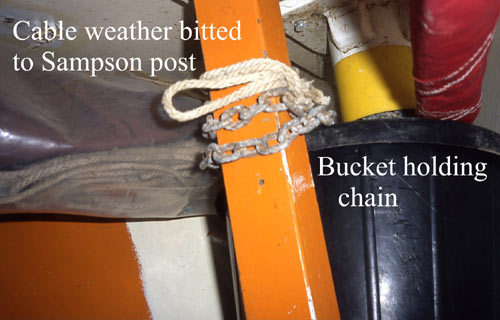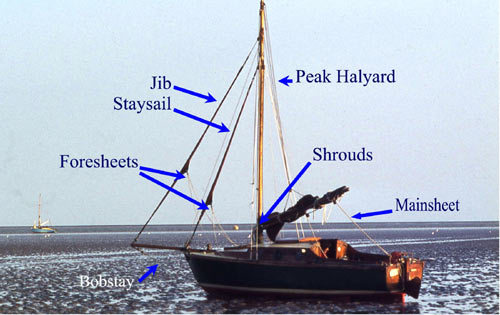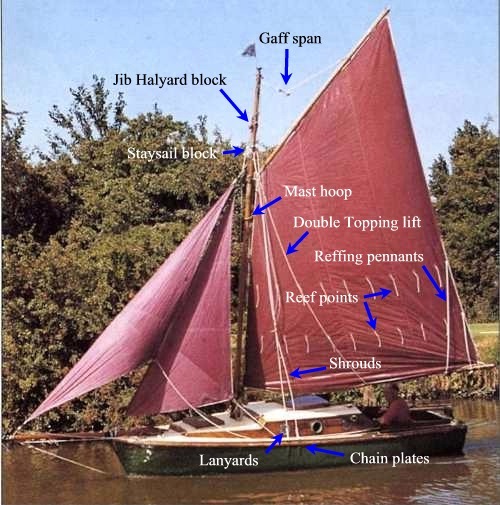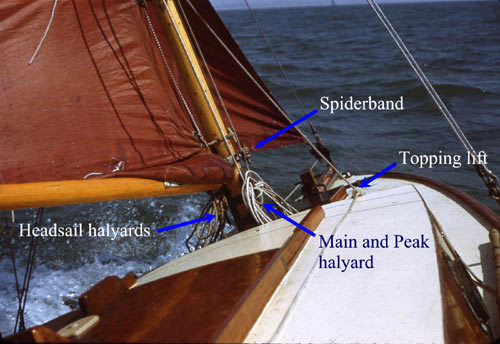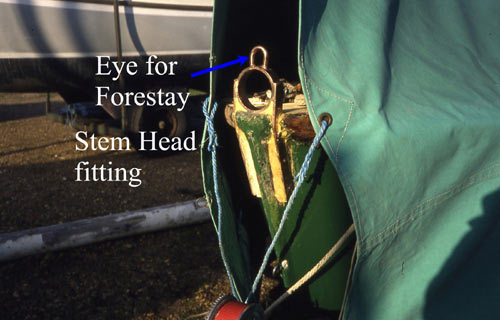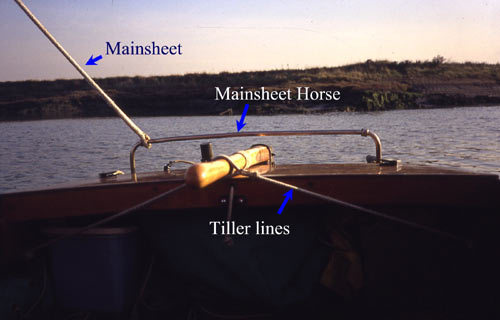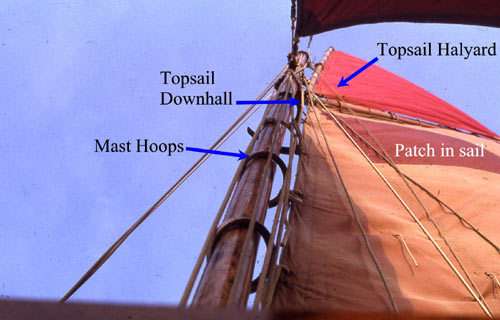The mast has a hole through it a few inches from the bottom for the tabernacle bolt that secures it but allows it to pivot. Above is a spider band with a fitting for the gooseneck, two eyes and two pins for use a cleats. Three quarters of the way up is as metal ring with four eyes. Above are two lugs on the back of the mast to retain the loop at the top of the forestay and the grommet for the jib halyard block. There is a small block in the cap for the pennant halyard.
The shrouds have loops at the top and are the first items to be passed over the mast head, the two starboard ones first, and pulled down hard over the upper iron ring which has four eyes. The shrouds should be behind the port and starboard eyes
The topping lift comes next. It is lashed to the port hand eye at the hounds, passed under the gooseneck in order that when the boom is fitted, it is under the boom. Then it passes through the hardwood eye fixed to the starboard eye at the hounds. Eventually it will run down to the hard eye on the front of the cabin top starboard side. I contain the gash by leading it down to an eye on the lower spider band and turning it back on itself with a rolling hitch.
The Staysail halyard (the one with a snap shackle) is passed through the block on the front of the upper ring and down to the forward cleat on the lower spider band.
The forestay can now be passed over the mast head to the lower of to wooden lugs on the back of the mast.
A block on a large grommet is passed over the head of the mast down to the higher wooden lug on the back of the mast. In order to do this, the lashing may have to be eased. It is then seized up tightly so that it can fall no further. The jib halyard (the longer of the two), is passed through this block and down to the other, after cleat on the spider band.
The peak halyard is passed through the masthead sheave with the snapshackle aft. It can be snapped for the time being to an eye on the stb side of the spiderband. The other end is attached to the adjacent cleat.
The throat halyard is passed through the block attached on the after ring at the hounds, the ends knotted together and tucked anywhere.
The burgee halyard is rove, knotted and tucked anywhere.
A lashing or two round the lot makes the mast easier to carry to the boat and slot into the tabernacle with the top in the boom crutch.
The mast can now hoisted upright and the forestay clipped to the stemhead.
The shrouds can now be attached to the shroudplates.
The boom can now be fitted onto the gooseneck, the topping lift slacked off and passed inside the brass fitting under the leather halfway along the boom(one side of which will have to be unscrewed). The tail from the hard eye at the front of he cabin top starboard side can be led to a cleat at the after end of the cabin top starboard side. A short piece of shock cord is lashed to an eye on the forward end of the boom starboard side, passed round the mast and clipped to the opposite eye port side to stop the boom jumping off.
The bowsprit is fitted next and has to pass through a grommet on the Wykeham Martin furling gear for the staysail.
The bobstay is fitted and the Wykeham Martin gear for the Jib.
The furling line for both gears is one line, looping port side aft of the cabin top to two cleats.
The mainsail is loose footed. BEFORE FIXING THE TACK, SLIP THE HARD RING ON THE LEECH OVER THE AFTER END OF THE BOOM. The leechline passes through the block at the end of the boom and is made fast to a cleat on the underside of the boom above the cabin hatch.
The peak halyard is clipped to the block on the gaff, the line across the gaff jaws is made fast and the mast hoops lashed on. The throat is shackled to the gaff. The lashing passes through the eye, over the spar and back inside itself and onto the next eye. The head is lashed as tightly as possible to the eye in the gaff.
The Jib is shackled on as I never change it, but the staysail is clipped on as I have two sizes.
The tacked head gear for the staysail is very complicated and I shall have to describe it after I have fitted it next year.


